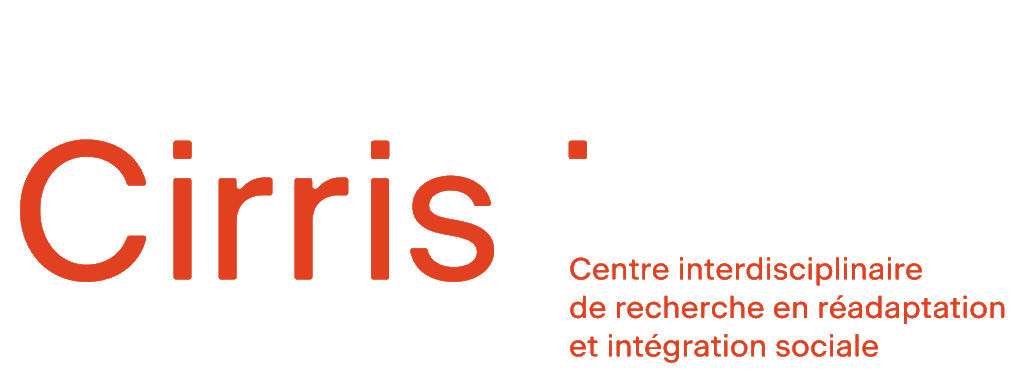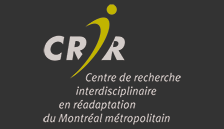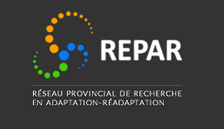Co-design of an Assistive Internet Navigation Device for People with Visual Impairments
The Internet is not inclusive for people with visual impairments. Indeed, assistive devices do not allow people with visual impairments to easily locate themselves on a web page, nor to interact quickly. However, the Internet has become an essential tool (especially during these pandemic times), for communicating, working, accessing leisure and social activities. Thus, this project aims to co-design an assistive device with users, partners, clinicians, research team, which can be adapted to online navigation for people with visual impairments. We will adopt the co-design method and, in this context, we will carry out focus groups, present some initiatives including a technological tool with haptic sensations reflecting the Web navigation hierarchy. One of the outcomes of the project will be to build and implement the device within the service offer of the partners for the people with visual impairments.
Objectives:
The main objective of this project is the co-design of the device. This project has four sub-objectives:
- Assess the user’s needs
- Develop the assistive device
- Test the performance of the device when performing an online task
- Evaluate the degree of satisfaction of users during their online interactions
Milestones:
- Co-design of the prototype
- Build the device & Co-creative Interactions
- Experimentation
- Analyses and final adjustments to the device
- Knowledge transfer
Results
This is an open source technology to facilitate Internet navigation for visually impaired and blind participants. It is a technology that complements the use of screen reading software, such as NVDA or JAWS. The project focuses on trying to provide a tactile version of the headings on a web page that the user can interact with directly with their hands, such as a mini-map of the web page under the palm of the hands.
The design is participatory, which means that users are at the forefront during the design process. Their opinions and experiences will shape the design developed during the research process.
To develop the technology with the participants and clinicians, 6 one-hour sessions spread over 4 months were conducted.
This is a new open source technology. This means that anyone in the world can build it, sell it and improve it, making it better over time. For example, a researcher elsewhere in the world can use this technology to attach metadata or the result of an algorithm to the mini-touch map, or a Braille display company can take the design and use its touch technology to make a high-end product. Each interaction with the technology will help the project mature.
Device Details
The device is about 3 cm thick, 13 cm high and 8 cm wide. On the left is the mini map, on this prototype there are 4 rows of dots to represent 4 headers. Future versions may include more rows. If a line has its first dot raised, it means it is a level 1 heading. If a line has its 4th dot raised, it is a level 4 heading.
To the right of each line is a button that allows you to interact with the title while browsing the web page. By briefly pressing the button, you can have the computer read aloud the text in the heading. Press twice to access the header.
Prototype testing
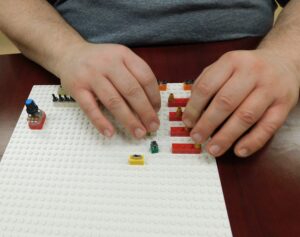
The participant tests a prototype made from lego in order to size the locations of the electronic components.
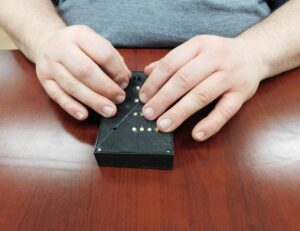
Here the participant interacts with the 3D printed version of the prototype.
Video presentation in English
More info
https://github.com/LibreTactile
Last update: February 21, 2023
Global progress
Co-creation of the prototype
Construction & Co-creative Interactions
Experimentation
Analyzes and final adjustments to the device
Knowledge transfer
Team members
Researchers:
- Jocelyne Kiss, Principal Investigator, Regular Researcher, CIRRIS and Professor, Département de design, Université Laval.
- Frédérique Poncet, Principal Investigator, Researcher, Centre de réadaptation Lethbridge-Layton-Mackay (CRLLM), CIUSSS du Centre-Ouest de l’Île-de-Montréal (CCOMTL).
- Walter Wittich, Co-Investigator, Regular Researcher, CRIR and Professor, École d’optométrie, Université de Montréal.
- Juan Nino, Student, PhD Student, Faculté de design, Université Laval.
Partners:
- France Picard, Principal Partner, Chef de service de la recherche, de l’innovation et du secteur de l’adaptation de l’information et médias substituts, Institut Nazareth et Louis-Braille, Direction des programmes déficiences (DI, TSA, DP et DV), CISSS de la Montérégie-Centre.
- Geneviève Chabot, Principal Partner, Rehabilitation Assistant Director, Centre de réadaptation Lethbridge-Layton-Mackay (CRLLM), Direction de la réadaptation et des services multidisciplinaires, CIUSSS Centre-Ouest.
- Pascale Dussault, Partner, Executive Director, Regroupement des aveugles et amblyopes du Montréal Métropolitain (RAAMM).
Scientific sectors
Innovation stages
- Émergence
All projects
- Accès à l’information et à sa compréhension pour une société inclusive
- Accompagnement par les pairs pour les personnes vivant avec la schizophrénie
- Co-development of intergenerational activities to break with ageism and support the social participation of people living with the after-effects of a traumatic brain injury.
- Action-research for the implementation of a hearing aid valorization program offered in the community and aimed at seniors with a hearing loss
- Improving the accessibility of information and communication in the Montréal Museum of Fine Arts
- Améliorer la connaissance de l’expérience utilisateur d’électroménagers pour des personnes vivant avec une déficience visuelle
- Améliorer la qualité de vie et la participation sociale des personnes en situation de handicap : identification des besoins à intégrer aux applications mobiles
- Offering learning opportunities adapted to autistic children: a lever for social participation
- Autisme et vieillissement : analyse des indicateurs de santé et de bien-être des personnes
- Avatar pour l’interprétation en langue parlée complétée (LPC)
- Para-athlete Technology Needs
- CARE PLAY: Community And REsearch PLAYing together using physical literacy knowledge translation tools targeting children with disabilities in Quebec
- Co-construction d’un cours de danse adaptée dans la communauté pour les enfants avec la paralysie cérébrale : Faire tomber les barrières
- Co-construction d’un programme de formation continue des acteurs municipaux en lien avec les plans d’action d’accessibilité universelle
- Co-construction of tools to foster inclusive environments for the social participation of adults with disabilities- in the context of gender and sexual diversity
- Co-design of an Assistive Internet Navigation Device for People with Visual Impairments
- Co-Creation of Leisure Experience in an Inclusive and Accessible Theatre Space: The Case of the Segal Centre for Performing Arts.
- Co-développement d’ateliers pour favoriser la connaissance de soi et la communication des adolescents avec un TDL
- Co-development of workshops to promote psychological well-being after a stroke
- Co-development of an active listening training for Autism Support volunteers
- Coconstruire des outils adaptés pour favoriser le pouvoir d’agir des personnes vulnérables atteintes de lombalgie.
- Co-constructing Neuroinclusion: Creating and piloting a tool to assess accessibility and inclusivity
- Codéveloppement d’une trousse d’outils pour soutenir l’émergence de tierces personnes inclusives en milieux de loisir.
- Comprendre et évaluer un camp intégrant intervention orthophonique et pairaidance en plein air pour les jeunes qui bégaient
- Understand and make others understand: Operationalizing an immersive design fiction tool to promote social participation by deaf people
- Connexion Spectrum : la sexualité et les saines relations
- Contraintes biomécaniques du basketball en fauteuil roulant
- De l’expérience à l’expertise : comprendre et construire les savoirs professionnels d’accompagnement pour renforcer l’engagement des superviseurs.es en entreprise adaptée
- Étude de cas en surdicécité visant à tester la faisabilité clinique, sociale et économique de nouvelles modalités de communication en face-à-face et à distance
- Exploring cognitive-social factors underlying pedestrian navigation following chronic moderate-to-severe traumatic brain injury (m/sTBI) using virtual environments
- Favoriser l’autodétermination lors de l’apprentissage de la conduite automobile chez les jeunes adultes ayant des incapacités
- Staff training and adapted physical activity
- Formation et familiarisation à l’utilisation du réseau régulier de transport en commun : un état de la situation des besoins et des ressources pour les personnes ayant des incapacités.
- Formation/entrainement pour faciliter l’utilisation des réseaux de bus et de métro accessibles par des personnes ayant des limitations fonctionnelles motrices
- Adapted physical activity for community organizations
- Identifying the Fundamental Movement Skills for Pediatric Manual Wheelchair Users: A Step Towards the Development of Inclusive Physical Education and Social Participation
- Impacts d’orthèses robotisées des membres supérieurs
- Inclusion sociale par l’activité physique en plein air chez les enfants atteints de trouble de développement de la coordination
- Artificial intelligence for people with Parkinson’s disease
- L’expérience des personnes handicapées dans le processus du CIPH avec leur médecin de famille
- The Mutual Aid Brigade: a vehicle for a stable, safe and healthy home.
- Le Café-IN : carrefour d’échange et de partages pour l’inclusion sociale des personnes ayant un traumatisme craniocérébral
- Les déterminants d’une expérience inclusive dans des ateliers créatifs : le cas du réseau des Bibliothèques de Montréal
- Logement social pour adultes autistes en quête d’autonomie
- Mobilizing the community, to design a support ecosystem adapted to women who are victims of domestic violence and have suffered a traumatic brain injury.
- Mon futur chez-moi en 3D – Map It
- Musées inclusifs : un état de la situation de l’accessibilité universelle dans les musées du Québec
- Participation sociale des personnes ayant des incapacités dans la dynamique de développement régional inclusif
- Fatherhood, co-parenting and disability: what are the experiences of fathers with disabilities in Quebec?
- For truly inclusive research: developing a training program co-developed with adults with intellectual disabilities
- Community matters: Promoting social participation for individuals living with early dementia and their partners.
- Pour une salle de classe inclusive
- Projet ceinture intelligente – Smartbelt
- Promoting Audiodiversity: The Right to (Fair) Self-Representation in the Media
- Recommendations for an inclusive digital budgeting assistance solution for individuals with traumatic brain injury.
- Réfléchir pour agir ensemble en formation et en sensibilisation
- Without taboos: Uniting for the inclusion of the sexual experiences and needs of adults with motor disabilities in sexology and rehabilitation
- Hiking trails: towards an accessible classification
- Soutenir ensemble la mobilité d’ainés présentant des incapacités: comment favoriser leur utilisation du transport en commun et leur participation sociale?
- Spina Bifida and aging: co-development of a toolbox
- Sport and rehabilitation
- Système électronique musical pour l’inclusion et la réadaptation
- Transition vers l’inclusion
- An Exploratory Study of Deaf and Hard of Hearing Women’s Access to Social Services
- Learning unit and inclusive work environment
- Utilisation des technologies de l’information et de la communication (TIC) d’usage courant par les personnes ayant une surdité
- Valoriser les pratiques quotidiennes des parents d’enfants ayant des particularités développementales : la créativité parentale comme moteur d’inclusion sociale
- Visitabilité des commerces
- Évaluation des exigences biomécaniques et physiologiques du ski paranordique

